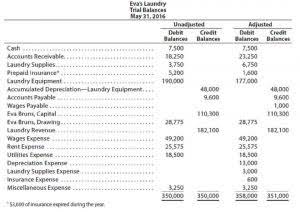
These statements are pulled from the chart of accounts, which maintains a running record of the various ledgers kept at your organization. If you’re like most nonprofit leaders, you didn’t get to the top of your organization by burying your nose in nonprofit financial statements. If the net change in cash is positive, then that means the nonprofit is ending the period with more cash than it started with, while a negative change indicates that the nonprofit’s cash on hand has decreased.
Are You Ready To Outsource Your Accounting?

Understanding the flow of cash through the organization allows stakeholders to evaluate its financial stability and make informed decisions regarding strategic planning and management. As shown, there are multiple transactions that require special attention during the preparation of a not-for-profit’s statement of cash flows. Understanding the correct way to report these transactions on the statement of cash flows can help ensure your organization’s financial position is depicted accurately. Blackbaud Financial Edge NXT simplifies nonprofit accounting, providing pre-built templates and intuitive tools to enhance reporting.

Financing Activities (Loans, Dividends, Sale of Stock)
- To enhance your understanding and efficiency in managing nonprofit finances, it is valuable to explore a range of educational resources and tools.
- By analyzing cash flow patterns, executive directors and board members can make informed decisions about budgeting, planning, and financial forecasting.
- Essentially, gross receipts refer to the total amount your nonprofit brings in from all sources – donations, memberships, grants, etc.
- Investing activities on a nonprofit’s Statement of Cash Flows reflect transactions involving the acquisition and disposal of long-term assets, such as property, plant, and equipment, as well as investments in securities.
- These mechanisms help safeguard assets, ensure accurate financial reporting, and promote operational efficiency.
- That means must use accrual-basis accounting and record transactions in a specific way.
The statement of cash flows is an indispensable financial document for nonprofit organizations. It provides a transparent, comprehensive view of cash inflows and outflows across operating, investing, and financing activities. This clarity is essential not only for managing day-to-day operations but also for planning long-term sustainability. This statement is crucial as it offers transparency into the liquidity and financial flexibility of the entity, unlike the income statement which is based on accrual accounting and includes non-cash revenues and expenses.

How to Tell If Your Financial Reports Are Lying to You
For nonprofit organizations, this statement is essential as it highlights how effectively the retained earnings organization manages its cash to fulfill its mission and maintain operational stability. Unlike for-profit businesses that focus heavily on profitability, nonprofits emphasize the sustainability of their cash flows to ensure they can continue providing services and support to their communities. Below is a list of useful links to further readings, tutorials, and professional guidance that can help strengthen your nonprofit’s financial acumen and reporting capabilities. By proactively addressing these common challenges and applying rigorous practices, nonprofits can enhance the accuracy and integrity of their cash flow statements prepared using the Direct Method. This not only aids in better financial management but also bolsters the confidence of donors, board members, and other stakeholders in the organization’s financial health. These key components—operating, investing, and financing activities—provide a comprehensive view of a nonprofit’s cash flow and are critical for assessing the organization’s financial health and operational efficiency.
- Nonprofits do not have commercial owners and must rely on funds from contributions, membership dues, program revenues, fundraising events, public and private grants, and investment income.
- Doing so runs the risk of upsetting donors and can cause issues with the audit process.
- It helps stakeholders understand the diversity and reliability of the organization’s revenue streams.
- When preparing or using a Statement of Cash Flows, several common mistakes can lead to inaccurate financial reporting or misinterpretation of the organization’s cash position.
- This can include things like cash from the sale of assets, cash from the repayment of loans, and cash from the issuance of new debt.
- The second step is to ensure you’re drawing the correct conclusions from the document, which we’ll cover in more detail in the next section.
Effective use of the Statement of Cash Flows in strategic planning enables nonprofit leaders to make informed decisions https://www.bookstime.com/articles/vertical-analysis that align with the organization’s mission and long-term goals, ensuring sustainable operation and growth. Most nonprofits generate these statements annually, though interim reports (monthly or quarterly) can be helpful for ongoing financial management. Unlike a for-profit balance sheet, the Statement of Financial Position emphasizes mission-driven resources rather than shareholder equity. Additionally, nonprofits distinguish between restricted and unrestricted funds, reflecting donor intentions. Financing activities include all the cash that comes in and goes out from your organization’s financing activities.
Importance of Accurate Classification of Cash Flows for Financial Transparency and Management
These examples highlight how critical cash flow analysis is in supporting strategic decisions that ensure the longevity and success of nonprofit organizations. By leveraging detailed cash flow information, nonprofits can navigate financial challenges more effectively and capitalize on opportunities to advance nonprofit statement of cash flows their missions. This reconciliation confirms the integrity of the cash flow statement and ensures consistency with the balance sheet, providing transparency and trust in the financial reporting. It is a critical step that verifies all cash transactions are accounted for accurately, reflecting the true financial position of the nonprofit at the end of the fiscal period. It measures cash inflows and cash outflows, and it helps with determining a company’s financial health and making sure there is enough cash available to pay off expenses. Monitoring cash flows from investing activities helps ensure that a nonprofit is not over-investing its liquid assets in ways that could jeopardize its operational liquidity.
Recap of the Benefits of the Direct Method for Nonprofits
An organization without owners and with the main purpose of providing services needed by society. Since the Form 990 filed by the nonprofit becomes public nonprofit statement of cash flows information, you can learn much about a nonprofit by reading the information on Form 990. The website guidestar.org is a resource one can use to obtain financial (and other) information reported on nonprofits’ Form 990.

Leave a Reply